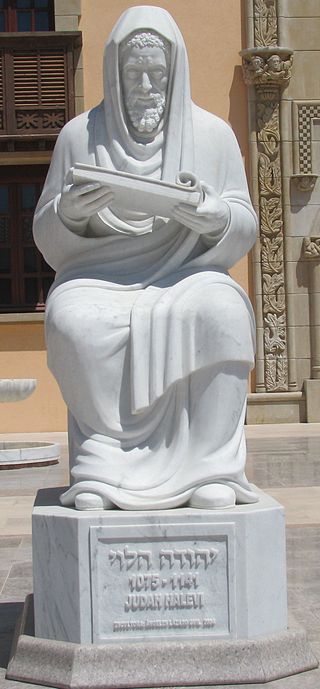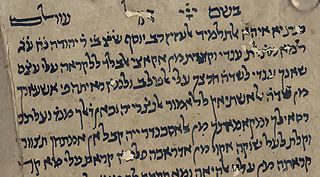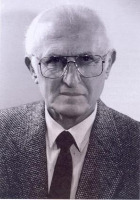
Judah Halevi was a Sephardic Jewish poet, physician and philosopher. He was born in Al-Andalus, either in Toledo or Tudela, in 1075. He is thought to have died in 1141, in either Jerusalem, at that point the Crusader Kingdom of Jerusalem, or in Alexandria, Egypt.

Dunash ha-Levi ben Labrat was a medieval Jewish commentator, poet, and grammarian of the Golden age of Jewish culture in Spain. He is known for his philological commentary, Teshuvot Dunash, and for his liturgical poems D'ror Yiqra and D'vai Haser.

Medieval Hebrew was a literary and liturgical language that existed between the 4th and 19th century. It was not commonly used as a spoken language, but mainly in written form by rabbis, scholars and poets. Medieval Hebrew had many features that distinguished it from older forms of Hebrew. These affected grammar, syntax, sentence structure, and also included a wide variety of new lexical items, which were either based on older forms or borrowed from other languages, especially Aramaic, Greek and Latin.

Solomon ibn Gabirol or Solomon ben Judah was an 11th-century Andalusian poet and Jewish philosopher in the Neo-Platonic tradition. He published over a hundred poems, as well as works of biblical exegesis, philosophy, ethics and satire. One source credits ibn Gabirol with creating a golem, possibly female, for household chores.
A piyyut or piyut is a Jewish liturgical poem, usually designated to be sung, chanted, or recited during religious services. Piyyutim have been written since Temple times. Most piyyutim are in Hebrew or Aramaic, and most follow some poetic scheme, such as an acrostic following the order of the Hebrew alphabet or spelling out the name of the author.
Rabbi Moses ben Jacob ibn Ezra, known as Ha-Sallaḥ was an Andalusi Jewish philosopher, linguist, and poet. He was born in Granada about 1055 – 1060, and died after 1138. Ibn Ezra is considered to have had great influence in the Arabic literary world. He is considered one of Spain's greatest poets and was thought to be ahead of his time in terms of his theories on the nature of poetry. One of the more revolutionary aspects of Ibn Ezra's poetry that has been debated is his definition of poetry as metaphor and how his poetry illuminates Aristotle's early ideas. The impact of Ibn Ezra's philosophical works was minor compared to his impact on poetry, but they address his concept of the relationship between God and man.
Hazaj meter is a quantitative verse meter frequently found in the epic poetry of the Middle East and western Asia. A musical rhythm of the same name is based on the literary meter.
ʿArūḍ is the study of poetic meters, which identifies the meter of a poem and determines whether the meter is sound or broken in lines of the poem. It is often called the Science of Poetry. Its laws were laid down by Al-Khalīl ibn Aḥmad al-Farāhīdī, an early Arab lexicographer and philologist. In his book Al-ʿArḍ, which is no longer extant, he described 15 types of meter. Later Al-Akhfash al-Akbar described a 16th meter, the mustadārik.

Ezra Fleischer was a Romanian-Israeli Hebrew-language poet and philologist.

Joseph Yahalom is a professor of Hebrew literature at the Hebrew University of Jerusalem. Since 1983, he has been a member of the Academy of the Hebrew Language.

Professor Shulamit Elizur, born April 6, 1955, is a scholar of ancient and medieval piyyut. She is the head of the Fleischer Institute for the Study of Hebrew Poetry, a member of the Academy of the Hebrew Language, and a member of the editorial board of the Mekize Nirdamim publishing house.
The golden age of Jewish poetry in Al-Andalus developed in the literary courts of the various taifas. Like its Arabic counterpart, its production diminished in the 12th century under the rule of the Almoravids and Almohads. In the last part of the 10th century, Dunash ben Labrat revolutionized Jewish poetry in Al-Andalus by bringing Arabic meter and monorhyme into Hebrew writing. Jewish poets employed Arabic poetic themes, writing bacchic poetry, garden poetry, and love poetry.
Piyyut is Jewish liturgical poetry, in Hebrew or occasionally Aramaic. Since the fifth century CE, piyyutim have been written in many different genres and subgenres. Most of these are defined by the function that the given poem fulfills in the context of Jewish prayer service; but a few are defined by other criteria, such as content.
Elohekhem is a genre of piyyut, which arose among Jews in 12th-century Germany, to be inserted in the Qedusha of the Musaf prayer. Several dozen poems of this genre were written over the course of the twelfth and thirteenth centuries.
Magen Avot is a genre of piyyut designed to be inserted into the blessing Berakha Aḥat Me‘en Sheva‘ in the Jewish liturgy for Friday evening, right before the words “Magen avot bidvaro”, from which the name of the genre is taken.
Authors of piyyut are known as paytanim. Piyyut is Jewish liturgical poetry, in Hebrew or occasionally Aramaic.
Zechariah (Yaḥya) al-Ḍāhirī, often spelled Zechariah al-Dhahiri, was the son of Saʻīd (Saʻadia) al-Ḍāhirī, from Kawkaban, in the District of al-Mahwit, Yemen, a place north-west of Sana’a. He is recognized as one of the most gifted Yemenite Jewish poets and rabbinic scholars who left Yemen in search of a better livelihood, travelling to Calicut and Cochin in India, Hormuz in Persia, Basra and Irbīl in Babylonia, Bursa and Istanbul in Anatolia, Rome in Italy, Aleppo and Damascus in Syria, Safed and Tiberias, as well as Jerusalem and Hebron in the Land of Israel, Sidon in Ottoman Lebanon and Egypt, and finally unto Abyssinia where he returned to Yemen by crossing the Erythraean Sea and alighting at a port city near Mocha, Yemen. He wrote extensively about his travels and experiences in these places, which he penned in a Hebrew rhymed prose narrative, and eventually publishing them in a book which he called Sefer HaMusar, in circa 1580.
Yemenite Jewish poetry, often referred to as "paraliturgical poetry" because of its religious nature, has been an integral part of Yemenite Jewish culture since time immemorial. The Jews of Yemen have preserved a well-defined singing arrangement which not only includes the very poetic creation itself, but also involves a vocal and dance performance, accompanied in certain villages outside Sana'a by drumming on an empty tin-can (tanakeh) or a copper tray. The Jews of Yemen, maintaining strict adherence to Talmudic and Maimonidean halakha, observed the gezeirah which prohibited playing musical instruments, and "instead of developing the playing of musical instruments, they perfected singing and rhythm." This arrangement was integrated into the walks of life familiar to the Jews of Yemen. The texts used in the arrangement were put down in writing and later included in separate song collections (dīwāns). The social strictures and norms in Yemenite Jewish culture provide for separate settings for men and for women, where the sexes are never mixed. Men’s song usually expressed the national aspirations of the Jewish people, and it was far removed from the singing associated with the Muslim environment, whereas folk songs of Jewish women were sung by rote memory and expressed the happiness and sorrows inherent in their daily life and was, as a rule, closer to that of Muslim women.
Wāfir is a meter used in classical Arabic poetry. It is among the five most popular metres of classical Arabic poetry, accounting for 80-90% of lines and poems in the ancient and classical Arabic corpus.
D'ror Yikra is a piyyut, of the kind known as zemer, traditionally sung during Sabbath meals, particularly the first meal on Friday evening.





